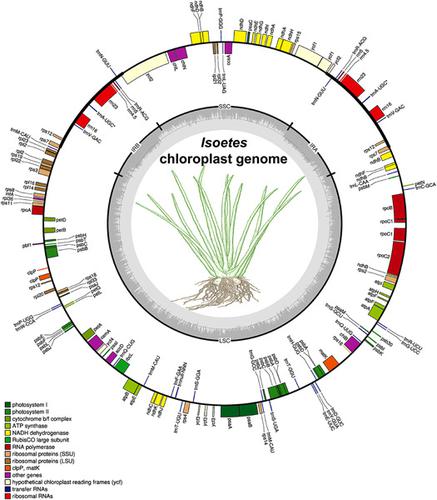当前位置:
X-MOL 学术
›
J. Syst. Evol.
›
论文详情
Our official English website, www.x-mol.net, welcomes your
feedback! (Note: you will need to create a separate account there.)
Chloroplast genomes of key species shed light on the evolution of the ancient genus Isoetes
Journal of Systematics and Evolution ( IF 3.4 ) Pub Date : 2020-09-29 , DOI: 10.1111/jse.12693 Jovani B. S. Pereira 1, 2 , Ana Maria Giulietti 1, 3 , Eder S. Pires 4 , Marcele Laux 4 , Maurício T. C. Watanabe 1 , Renato R. M. Oliveira 4 , Santelmo Vasconcelos 4 , Guilherme Oliveira 4
Journal of Systematics and Evolution ( IF 3.4 ) Pub Date : 2020-09-29 , DOI: 10.1111/jse.12693 Jovani B. S. Pereira 1, 2 , Ana Maria Giulietti 1, 3 , Eder S. Pires 4 , Marcele Laux 4 , Maurício T. C. Watanabe 1 , Renato R. M. Oliveira 4 , Santelmo Vasconcelos 4 , Guilherme Oliveira 4
Affiliation

|
Although phylogenetic studies have revealed major clades, the deepest relationships in Isoetes remain unresolved. The use of next-generation sequencing provides enormous amounts of gene sequences, which allows not only clarification of the basal relationships but also rapid radiations. Plastomes of six key Isoetes species were annotated, revealing a total of 129 or 130 genes, depending on the species. Our phylogenomic analyses comprising representatives of all major clades yielded well-supported nodes and identical topologies using maximum likelihood and Bayesian inference. The phylogenetic reconstructions detangled the deep relationships in Isoetes and illuminated the more recent radiations in the genus. A basal dichotomy was found that grouped Isoetes spp. from Brazil and South Africa into a clade sister to the remaining Isoetes groups. Interestingly, I. andicola was found to be sister to the North American species complex. Genomic trait mapping analysis showed that the missing introns in the atpF and clpP genes were well conserved in two major clades. The absence of trnK-UUU was observed in the Brazilian tropical species and in I. velata. Among lycophytes, the gene trnR-CCG was missing only in I. eludens. In general, genomic traits such as the presence or absence of internal stop codons, a tRNA, and an intron were revealed to be conserved within groups, suggesting that these genomic traits might reveal vital information about the evolution of the genus. This study will contribute to understanding the diversification of Isoetes and the establishment of a better framework to address the evolutionary history of the genus.
中文翻译:

关键物种的叶绿体基因组揭示了古老的 Isoetes 属的进化
尽管系统发育研究揭示了主要进化枝,但Isoetes 中最深的关系仍未解决。下一代测序的使用提供了大量的基因序列,这不仅可以澄清基础关系,还可以进行快速辐射。对 6 个关键Isoetes物种的质体进行了注释,根据物种的不同,总共揭示了 129 或 130 个基因。我们的系统发育分析包括所有主要进化枝的代表,使用最大似然和贝叶斯推理产生了支持良好的节点和相同的拓扑结构。系统发育重建解决了Isoetes 中的深层关系,并阐明了该属中最近的辐射。发现了一个基本的二分法,分组Isoetes spp。从巴西和南非成为其余Isoetes群体的进化枝姐妹。有趣的是,发现I. andicola是北美物种复合体的姐妹。基因组性状作图分析表明,atpF和clpP基因中缺失的内含子在两个主要进化枝中都非常保守。由于缺乏trnK-UUU在巴西的热带物种中观察到一velata。在石松植物中,基因trnR-CCG仅在I. eludens 中缺失. 一般而言,基因组特征(例如内部终止密码子、tRNA 和内含子的存在与否)在群体内是保守的,这表明这些基因组特征可能揭示有关该属进化的重要信息。这项研究将有助于了解Isoetes的多样化和建立一个更好的框架来解决该属的进化历史。
更新日期:2020-09-29
中文翻译:

关键物种的叶绿体基因组揭示了古老的 Isoetes 属的进化
尽管系统发育研究揭示了主要进化枝,但Isoetes 中最深的关系仍未解决。下一代测序的使用提供了大量的基因序列,这不仅可以澄清基础关系,还可以进行快速辐射。对 6 个关键Isoetes物种的质体进行了注释,根据物种的不同,总共揭示了 129 或 130 个基因。我们的系统发育分析包括所有主要进化枝的代表,使用最大似然和贝叶斯推理产生了支持良好的节点和相同的拓扑结构。系统发育重建解决了Isoetes 中的深层关系,并阐明了该属中最近的辐射。发现了一个基本的二分法,分组Isoetes spp。从巴西和南非成为其余Isoetes群体的进化枝姐妹。有趣的是,发现I. andicola是北美物种复合体的姐妹。基因组性状作图分析表明,atpF和clpP基因中缺失的内含子在两个主要进化枝中都非常保守。由于缺乏trnK-UUU在巴西的热带物种中观察到一velata。在石松植物中,基因trnR-CCG仅在I. eludens 中缺失. 一般而言,基因组特征(例如内部终止密码子、tRNA 和内含子的存在与否)在群体内是保守的,这表明这些基因组特征可能揭示有关该属进化的重要信息。这项研究将有助于了解Isoetes的多样化和建立一个更好的框架来解决该属的进化历史。











































 京公网安备 11010802027423号
京公网安备 11010802027423号